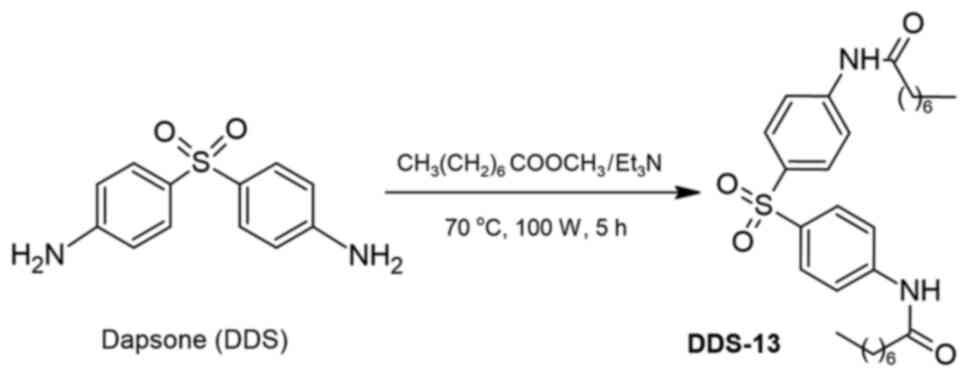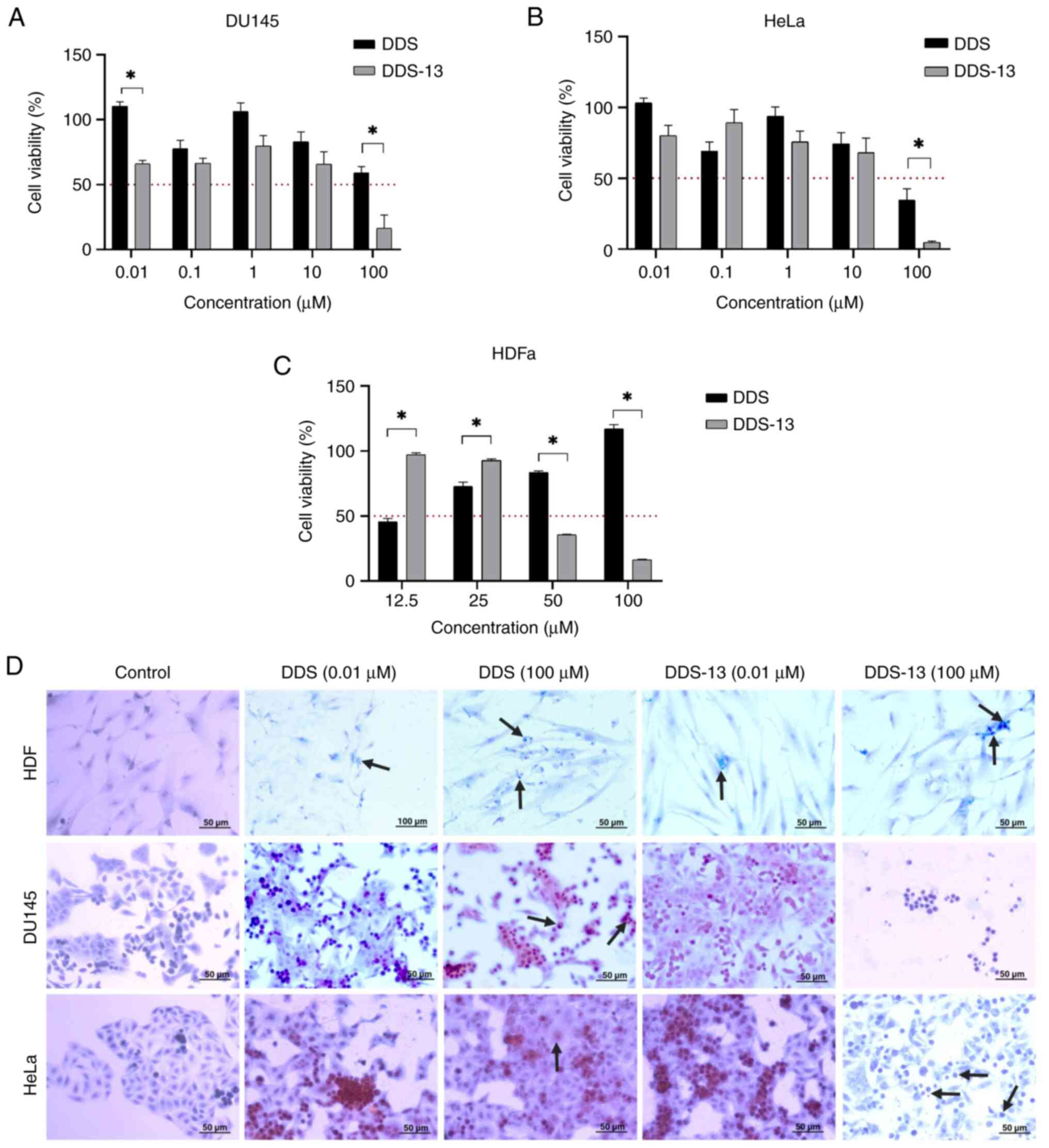|
1
|
Catherine Sánchez N: Knowing and
understanding the cancer cell: physiopathology of cancer. Rev Méd
Clin Las Condes. 24:553–562. 2013.
|
|
2
|
World Health Organization (WHO):
International Agency for Research on Cancer. WHO, Geneva, 2020.
https://gco.iarc.fr/today/online-analysis-multi-bars.
|
|
3
|
Ghose S, Radhakrishnan V and Bhattacharya
S: Ethics of cancer care: Beyond biology and medicine.
Ecancermedicalscience. 13(911)2019.PubMed/NCBI View Article : Google Scholar
|
|
4
|
Jarada TN, Rokne JG and Alhajj R: A review
of computational drug repositioning: Strategies, approaches,
opportunities, challenges, and directions. J Cheminform.
12(46)2020.PubMed/NCBI View Article : Google Scholar
|
|
5
|
Ross CM: The treatment of acne vulgaris
with dapsone. Br J Dermatol. 73:367–370. 1961.PubMed/NCBI View Article : Google Scholar
|
|
6
|
Reunala T, Hervonen K and Salmi T:
Dermatitis herpetiformis: An update on diagnosis and management. Am
J Clin Dermatol. 22:329–338. 2021.PubMed/NCBI View Article : Google Scholar
|
|
7
|
Wozel G and Blasum C: Dapsone in
dermatology and beyond. Arch Dermatol Res. 306:103–124.
2014.PubMed/NCBI View Article : Google Scholar
|
|
8
|
Molinelli E, Paolinelli M, Campanati A,
Brisigotti V and Offidani A: Metabolic, pharmacokinetic, and
toxicological issues surrounding dapsone. Expert Opin Drug Metab
Toxicol. 15:367–379. 2019.PubMed/NCBI View Article : Google Scholar
|
|
9
|
Boccellino M, Quagliuolo L, Alaia C,
Grimaldi A, Addeo R, Nicoletti GF, Kast RE and Caraglia M: The
strange connection between epidermal growth factor receptor
tyrosine kinase inhibitors and dapsone: From rash mitigation to the
increase in anti-tumor activity. Curr Med Res Opin. 32:1839–1848.
2016.PubMed/NCBI View Article : Google Scholar
|
|
10
|
Kanoh S, Tanabe T and Rubin BK: Dapsone
inhibits IL-8 secretion from human bronchial epithelial cells
stimulated with lipopolysaccharide and resolves airway inflammation
in the ferret. Chest. 140:980–990. 2011.PubMed/NCBI View Article : Google Scholar
|
|
11
|
Karpel-Massler G, Kast RE, Siegelin MD,
Dwucet A, Schneider E, Westhoff MA, Wirtz CR, Chen XY, Halatsch ME
and Bolm C: Anti-glioma activity of dapsone and its enhancement by
synthetic chemical modification. Neurochemical Res. 42:3382–3389.
2017.PubMed/NCBI View Article : Google Scholar
|
|
12
|
Lindenberg M, Kopp S and Dressman JB:
Classification of orally administered drugs on the World Health
Organization model list of essential medicines according to the
biopharmaceutics classification system. Eur J Pharm Biopharm.
58:265–278. 2004.PubMed/NCBI View Article : Google Scholar
|
|
13
|
Gallardo CA, Fan BE, Lim KGE and Kuperan
P: Chronic dapsone use causing methemoglobinemia with oxidative
hemolysis and dyserythropoiesis. Am J Hematol. 96:1715–1716.
2021.PubMed/NCBI View Article : Google Scholar
|
|
14
|
Vogel AI, Furniss BS, Hannaford AJ, Smith
PW and Tatchell AR: Vogel's textbook of practical organic
chemistry. 5th edition. John Wiley & Sons, New York, NY,
pp395-469, 1989.
|
|
15
|
Lidstrom P, Tierney J, Wathey B and
Westman J: Microwave assisted organic synthesis-a review.
Tetrahedron. 57:9225–9283. 2001.
|
|
16
|
Lipinski CA, Lombardo F, Dominy BW and
Feeney PJ: Experimental and computational approaches to estimate
solubility and permeability in drug discovery and development
settings. Adv Drug Deliv Rev. 46:3–26. 2001.PubMed/NCBI View Article : Google Scholar
|
|
17
|
Ghose AK, Viswanadhan VN and Wendoloski
JJ: A knowledge-based approach in designing combinatorial or
medicinal chemistry libraries for drug discovery. 1. A qualitative
and quantitative characterization of known drug databases. J Comb
Chem. 1:55–68. 1999.PubMed/NCBI View Article : Google Scholar
|
|
18
|
Veber DF, Johnson SR, Cheng HY, Smith BR,
Ward KW and Kopple KD: Molecular properties that influence the oral
bioavailability of drug candidates. J Med Chem. 45:2615–2623.
2002.PubMed/NCBI View Article : Google Scholar
|
|
19
|
Egan WJ, Merz KM Jr and Baldwin JJ:
Prediction of drug absorption using multivariate statistics. J Med
Chem. 43:3867–3877. 2000.PubMed/NCBI View Article : Google Scholar
|
|
20
|
Muegge I, Heald SL and Brittelli D: Simple
selection criteria for drug-like chemical matter. J Med Chem.
44:1841–1846. 2001.PubMed/NCBI View Article : Google Scholar
|
|
21
|
Sathawane P, Kamal MM, Deotale PR and
Mankar H: Nuances of the Papanicolaou stain. Cytojournal.
19(43)2022.PubMed/NCBI View Article : Google Scholar
|
|
22
|
Swiss Institute of Bioinformatics (SIB):
SwissADME. http://www.swissadme.ch/index.php#.
|
|
23
|
March-Vila E, Pinzi L, Sturm N, Tinivella
A, Engkvist O, Chen H and Rastelli G: On the integration of in
silico drug design methods for drug repurposing. Front Pharmacol.
8(298)2017.PubMed/NCBI View Article : Google Scholar
|
|
24
|
do Amaral LH, do Carmo FA, Amaro MI, de
Sousa VP, da Silva L, de Almeida GS, Rodrigues CR, Healy AM and
Cabral LM: Development and characterization of dapsone cocrystal
prepared by scalable production methods. AAPS PharmSciTech.
19:2687–2699. 2018.PubMed/NCBI View Article : Google Scholar
|
|
25
|
Jornada DH, dos Santos Fernandes GF, Chiba
DE, de Melo TR, dos Santos JL and Chung MC: The prodrug approach: A
successful tool for improving drug solubility. Molecules.
21(42)2015.PubMed/NCBI View Article : Google Scholar
|
|
26
|
Day TP, Sil D, Shukla NM, Anbanandam A,
Day VW and David SA: Imbuing aqueous solubility to amphotericin B
and nystatin with a vitamin. Mol Pharm. 8:297–301. 2011.PubMed/NCBI View Article : Google Scholar
|
|
27
|
Schilder RJ, Sill MW, Lee YC and Mannel R:
A phase II trial of erlotinib in recurrent squamous cell carcinoma
of the cervix: A gynecologic oncology group study. Int J Gynecol
Cancer. 19:929–933. 2009.PubMed/NCBI View Article : Google Scholar
|
|
28
|
Davis ID, Martin AJ, Stockler MR, Begbie
S, Chi KN, Chowdhury S, Coskinas X, Frydenberg M, Hague WE, Horvath
LG, et al: Enzalutamide with standard first-line therapy in
metastatic prostate cancer. N Engl J Med. 381:121–131.
2019.PubMed/NCBI View Article : Google Scholar
|
|
29
|
Daina A and Zoete V: A BOILED-Egg to
predict gastrointestinal absorption and brain penetration of small
molecules. ChemMedChem. 11:1117–1121. 2016.PubMed/NCBI View Article : Google Scholar
|
|
30
|
Pillai V, Kadu R, Buch L and Singh VK:
Derivatives of dapsone (dap): Synthesis and study on in vitro
anticancer activity and DNA laddering against Hep G2 and C6 human
cancer cell lines. ChemistrySelect. 2:4382–4391. 2017.
|
|
31
|
Huang SM, Strong JM, Zhang L, Reynolds KS,
Nallani S, Temple R, Abraham S, Habet SA, Baweja RK, Burckart GJ,
et al: New era in drug interaction evaluation: US food and drug
administration update on CYP enzymes, transporters, and the
guidance process. J Clin Pharmacol. 48:662–670. 2008.PubMed/NCBI View Article : Google Scholar
|
|
32
|
Uetrecht J, Zahid N, Shear NH and Biggar
WD: Metabolism of dapsone to a hydroxylamine by human neutrophils
and mononuclear cells. J Pharmacol Exp Ther. 245:274–279.
1988.PubMed/NCBI
|
|
33
|
Tian D and Hu Z: CYP3A4-mediated
pharmacokinetic interactions in cancer therapy. Curr Drug Metab.
15:808–817. 2014.PubMed/NCBI View Article : Google Scholar
|
|
34
|
Guzmán-Ávila R, Avelar M, Márquez EA,
Rivera-Leyva JC, Mora JR, Flores-Morales V and Rivera-Islas J:
Synthesis, in vitro, and in silico analysis of the antioxidative
activity of dapsone imine derivatives. Molecules.
26(5747)2021.PubMed/NCBI View Article : Google Scholar
|
|
35
|
Zasosov VA: Diacyl derivatives of bis
(4-aminophenyl) sulfone. Zhurnal Obshchei Khimii. 17:471–476.
1947.
|
|
36
|
Hensel; Walter; Buechner O, inventor
Polyolefin molding compositions containing diamides, 1967.
|












